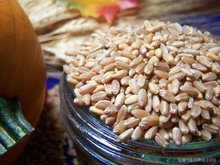Don’t let the word ‘wheat’ in it’s name confuse you. Buckwheat (Fagopyrum esculentum) looks like a grain and tastes like a grain but isn't a grain at all. Buckwheat is thought of as a cereal, but is actually an herb of the buckwheat family, Polygonaceae, a relative of the rhubarb. Buckwheat is also gluten free, which makes it an ideal food for those allergic or sensitive to the gluten in found wheat and other true grains. After being removed from the husk, the triangular seeds are used to make flour.
Buckwheat has been eaten for hundreds of years in the Far East. Buckwheat can also be used for a variety of baked products, including pancakes, breads, muffins, crackers, bagels, cookies, and tortillas , pasta, bread and Japanese soba noodles. The de-hulled seeds (groats) can be ground into grits and roasted to make kasha, served as a starchy side dish by people of a variety of ethnic backgrounds, especially Russians and eastern Europeans.
One pound of raw buckwheat has 1,520 calories. Nutritionally, buckwheat provides vitamins B1 and B2, the minerals potassium, magnesium, phosphate and iron (buckwheat contains more iron than cereal grains), and it has nearly twice the amount of the amino acid lysine found in rice. Buckwheat bran (farinetta) contains rutin, a flavonoid known to reduce cholesterol, lower blood pressure and maintain the strength and flexibility of capillaries. A recently discovered compound in buckwheat called fagopyritol may have potential to help manage type II diabetes.
Technorati Tags: Buckwheat, wheat, gluten

Are whole wheats the answer to a healthy life? Find out here.
Friday, May 18, 2007
Buckwheat - is it wheat or what?
Posted by
Millers Grain House
at
1:24 PM
![]()
Subscribe to:
Post Comments (Atom)


No comments:
Post a Comment